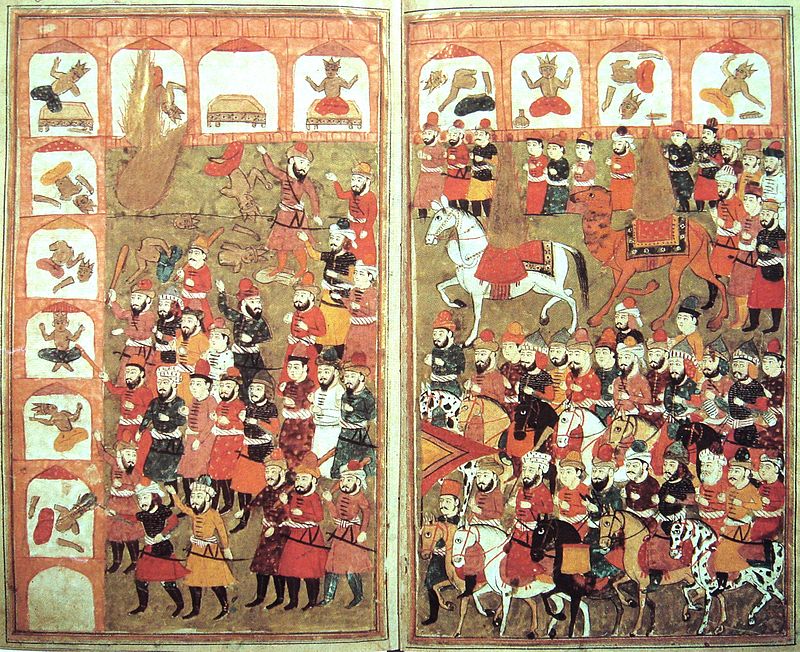Theodoric the Great
Early Life
Few Roman emperors received the title “The Great” and one of them was the Ostrogoth king Theodoric the Great. He was born in the 454 AD in Pannonia where he is listed on the Bible Timeline Chart with World History. This was a period when the Western Roman Empire was on the brink of collapse. The Ostrogoth people that his father, King Theodemir ruled, were restless and hungry because of their overcrowded conditions and lack of available land that they could farm. They were also besieged by other tribes in the area which pushed them to venture outside of Pannonia and into the Eastern Roman’s Empire’s territories in search of land and food.
Quickly See 6000 Years of Bible and World History Together

Unique Circular Format – see more in less space.
Learn facts that you can’t learn just from reading the Bible
Attractive design ideal for your home, office, church …
When Theodoric reached seven years old, he was taken to Constantinople as a hostage to guarantee that the Ostrogoths would stop all raids on the Eastern empire’s territory. In Constantinople, Theodoric received the best education the Eastern Romans could provide, and the young Ostrogoth excelled in administration and military strategies. Later, he returned to his people in Pannonia at age eighteen and was sent back by Emperor Leo with great gifts.
Theodoric wasted no time and joined his father in a battle against the Sarmatian king Babai upon his return. Theodoric also led 6,000 Ostrogoth warriors to besiege the city of Singidunum and later joined his father in the invasion of the cities of Naissus, Ulpiana, Heraclea, and Larissa. But Theodemir decided to continue south to the Greek city of Thessalonica after he was dissatisfied with their plundered goods. To prevent a full-scale invasion, the Roman general who governed Thessalonica brokered a truce with the Ostrogoths with a provision that he would hand over some territories for the invaders. The Ostrogoths happily went on their way after they received this treaty and settled on their new lands. Theodemir died after an illness in 475 AD.

Theodoric: King of Ostrogoths and Romans in Italy
Before his death, Theodemir appointed his son Theodoric as king of the Ostrogoths. Upon Theodoric’s accession as king, Emperor Zeno invited him to Constantinople and the new Ostrogoth ruler was received in the city with great honors. Zeno also appointed him as Magister militum (Master of the Soldiers) in 483 AD and Theodoric served as consul the following year. Theodoric returned to the Ostrogoth territory in 488 AD, but the restless and hungry tribe remained a threat to Emperor Zeno. The Eastern Roman emperor was also worried that Odoacer had grown more powerful in Italy after he removed the last Roman emperor of the west from his throne.
Zeno decided to solve the Ostrogoth’s overwhelming need for land and food, as well as the problem of Odoacer with one idea: he sent Theodoric West to remove the usurper from the throne and allowed the Ostrogoths to settle in Italy. Theodoric agreed to this plan and rallied a ragtag army made up of Huns, Ostrogoths, and Roman mercenaries who helped him besiege the Western Roman capital of Ravenna. It had taken three years of fighting before Odoacer and Theodoric were able to reach a truce, and both agreed to rule the west as co-emperors. As both men and their warriors celebrated the treaty, Theodoric killed Odoacer and started to rule Italy alone.
Theodoric married his way to alliances with other Germanic tribes during much of his reign. He married the Frankish princess Audofleda (sister of King Clovis I) as a way to build an alliance with the Franks, but tensions between the two tribes continued even after the union of the two. Theodoric also married his daughters (by his Moesian concubine) to Alaric, king of the Visigoths, and Sigismund, king of Burgundy. He gave his daughter Amalaesuntha to Eutharic of the Amali Dynasty of Visigothic Spain, while his sister married Thrasamund, king of the Vandals. Another daughter also married the king of the Thuringians.
Legacy
Theodoric ruled for 33 years, and his reign was generally peaceful, but his powers as king were severely limited. For example, the Goths were forbidden to legally marry Roman citizens, and he did not have the power to appoint Goths to any position in the government. They were Arian Christians and were considered as heretics by the Romans who believed in Catholicism. Theodoric also prohibited the Romans from carrying weapons and Goths were the only ones allowed to enlist in the army—a departure from the discrimination the Goths faced during the reign of earlier Roman emperors. To Theodoric’s credit, he pursued fairness in the treatment between Goths and Romans and appealed to his fellow Goths to treat the Roman citizens fairly.
Before his death, Theodoric proclaimed his 10-year old grandson Athalaric (the son of Alaric and Amalaesuntha) as king of the Ostrogoths in Italy.
Picture By Droysen/Andrée; G. Kossina rev. – Allgemeiner Historischer Handatlas, Public Domain, https://commons.wikimedia.org/w/index.php?curid=16288821
Bauer, Susan Wise. The History of the Medieval World: From the Conversion of Constantine to the First Crusade. New York: W.W. Norton, 2010.
Jordanes, Cassiodorus, and Charles Christopher Mierow. The Gothic History of Jordanes in English Version. Cambridge: Speculum Historiale, 1960.










